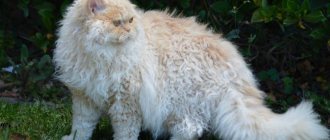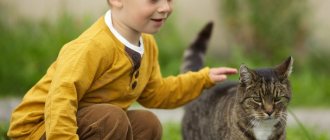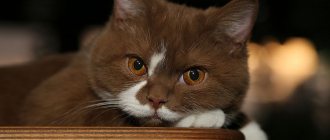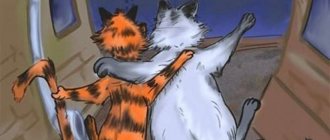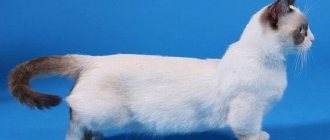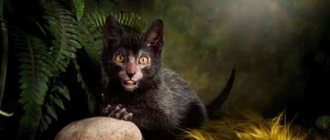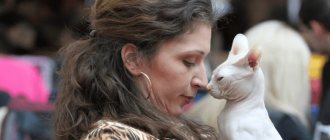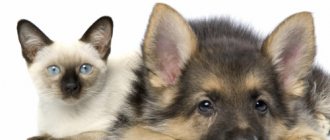Siberian
Representatives of this breed are the most popular in Russia. This is due to the beautiful appearance of the animal and its absolute safety for allergy sufferers. The Siberian cat does not cause allergic reactions, despite its long and thick fur. Its hypoallergenicity is caused by a low concentration of the Fel D1 protein, which is responsible for allergic reactions.
Representatives of this cat breed are distinguished by a calm and balanced character. They are affectionate, gentle and friendly, making them suitable for families with small children.
Read more about the Siberian cat breed
Russian blue cat
The Russian Blue cat, as its name suggests, is the most popular cat in Russia, but in recent decades it has gained more and more fans in other parts of the world. In fact, it is not blue, the wool comes in gray tones: from very light, through pigeon to granite gray. They are loving and strongly attached to their owners.
Origin and popularity
Russian blue cats are a natural breed, meaning they are not man-made, and are believed to have first been spotted in the ports of cities in northern Russia. However, after the war, this breed also suffered and almost disappeared, requiring them to be bred with Siamese cats close to their characteristics in order to survive.
Characteristic
If you are looking for a playful cat, this is not for you. But if you are looking for a calm pet that truly loves you and lets you pet him, well, the Russian Blue is the right choice.
These unusual cats live from 10 to 20 years, depending largely on their care.
Ragdoll
Are you interested in what is the most popular cat breed with a gentle and affectionate character? Pay attention to the ragdoll. Cats and cats of this breed are suitable for those people who need to constantly take care of someone. The Ragdoll will follow its owner and expect care and affection from him. This is one of the largest and fluffiest breeds, which is why it gained its popularity. Such an unusual name for a furry pet is due to its gentle character and ability to relax in the owner’s arms, like a “rag doll.”
Such cats easily get along with the smallest children and show them affection and care. Even during play, they never release their claws, and therefore do not pose a danger.
Read more about the Ragdoll breed
British breed
The British are very imposing and slow. They probably have the densest and thickest fur among cats. Because of this, they are often compared to plush toys.
They know their worth and often seem like real egoists to others. If these cats allow themselves to be picked up, it is more like a descent towards you. But more often than not, they will not be pleased with the manifestations of affection from a person. They often show waywardness and show their aristocracy with all their appearance.
The British do not tend to show aggression; they are restrained and remain calm in any situation.
This breed tolerates long periods of loneliness and is suitable for people who work a lot.
British Shorthair
Representatives of this noble breed have a long history. It is believed that it was brought to England by the Romans in the first century AD. Many years later, the British Shorthair cat was crossed with the Persian. The result was a new breed with a thicker coat and slightly modified appearance. It is in this form that the representative of the breed is known today.
"British" are very smart and loyal animals. They do not impose their company, they do not always even allow themselves to be stroked, it all depends on their mood. These pets can be alone for long periods of time. Because of this personality trait, they are called “business cats.” For this reason, "British" cats are the most popular cats among business people.
Read more about the British Shorthair cat breed
The most popular cat breeds. Top 20 (with photos)
19th place. Burmese cat (Burmese) . The short-haired breed is native to Southeast Asia. In Burma (modern name Myanmar), such cats were kept in Buddhist temples and were considered the reincarnation of deceased monks.
see also Buddhist Cats
18th place. The Siberian cat is a famous Russian breed of semi-long-haired cats, which got its name due to its place of origin - Siberia.
17th place. The Tonkinese cat is a hybrid of the American-type Siamese and Burmese cats.
16th place. Russian Blue . The breed traces its origins to the cats of the ancient Slavs. This breed became known outside Russia in 1893, when the English breeder Karen Cox brought two blue kittens from Arkhangelsk. The main distinguishing feature of the breed is its short blue coat with a beautiful silver tint. Russian Blue is one of the most expensive cat breeds.
15th place. The Burmese cat (sacred Burmese) is a breed of semi-long-haired cat that originates from Burma (Myanmar). It should not be confused with the Burmese cat, which is a separate breed of short-haired cat. The Burmese cat is recognizable due to its unusual color, which is called the Burmese color after the name of the breed. Cats with this color are characterized by the presence of white “gloves” with the point color of long hair.
14th place. The Norwegian Forest Cat is a breed of domestic semi-longhaired cat originally from Norway. The breed's ancestors were ship's cats on Viking longships.
13th place. Cornish Rex . A short-haired breed of domestic cat originally from Great Britain. The main distinguishing feature of the Cornish Rex is their coat. It has no guard hairs, and the undercoat is curled into a dense wave, reminiscent of astrakhan fur in structure.
12th place. The Siamese cat is a breed originally from Thailand (its old name is Siam).
11th place. The Devon Rex is a breed of short-haired domestic cat that originated in Great Britain. Representatives of this breed have a very extraordinary appearance: their fragile body is covered with soft curly hair, and their head is decorated with huge ears.
10th place. Oriental cat (oriental) . This shorthaired breed's ancestors are from Thailand, but it officially originated in the United States.
9th place. The Canadian Sphynx is a breed of hairless cat whose history officially began in 1966 in Canada, but there is evidence that these unusual creatures were known back to the times of the Egyptian pharaohs and were common in the Aztec and Incas temples in ancient Mexico.
8th place. The Abyssinian cat is one of the oldest cat breeds. Abyssinia is the former name of Ethiopia, where this breed originates.
7th place. The Scottish Fold (or Scottish Fold) is a very interesting breed of cat, the main distinguishing feature of which is the characteristic structure of the ears, curved forward and down. This unusual detail of their appearance is a consequence of a gene mutation. The first representative of this breed was discovered in 1961 in Scotland.
6th place. American shorthair cat . The ancestors of this breed were brought by the first settlers from Europe to North America.
5th place. British shorthair cat. This breed is the most popular in the UK.
4th place. Ragdoll is a breed of semi-long-haired cat. The name of the breed is translated as “rag doll”, because. Ragdolls phlegmatically accept any actions towards them: they can be stroked, squeezed, or put in certain positions.
3rd place. The Maine Coon is a large breed of domestic cat whose ancestors lived on the farms of Maine (Northeast America). Due to their original black striped color and large fluffy tail, they looked like raccoons - hence the second part of the name “coon”, that is, “raccoon”.
see also The largest breeds of domestic cats
2nd place. Persian cat . The ancestors of the modern breed were taken from Persia (modern name Iran) to Italy in the 17th century. In 2012 and 2013, the Persian cat was the most popular breed in the world, but in the last two years it has been content with only second place.
1 place. The exotic cat (exotic cat) is a breed of shorthair cat artificially created by American breeders in the 1960s by crossing American shorthair cats with Persian cats. In 2014 and 2015, exotics managed to surpass in popularity even their long-haired ancestors - Persian cats.
see also The rarest cat breeds
American Shorthair
Representatives of this popular breed of pets are very playful and carefree, but at the same time they always maintain their independence. They do not impose their society and demand the same from the owner. The cat loves to be around, but is extremely rarely held in your arms; this happens only at its request. Even in domestic conditions, the breed retains its predatory instinct and loves to hunt mice.
The American Shorthair cat easily survives the long absence of its owner. Such a four-legged friend is acquired by people who spend a lot of time at work and often travel on business trips.
Read more about the American Shorthair breed
The rarest short-haired and hairless species
Acquaintance with exclusive species begins with large spotted domestic cats. They are not classified based on origin, although they all have a common feature - mixing with wild animals.
- Steppe lynx or caracal. It is a predator, but is quickly tamed and in a number of countries lives next to people as a domestic cat. The caracal fell into the category of rare breeds due to the danger of complete extinction of the population.
- Savannah is a hybrid of a regular cat and an African serval. Breeding started in the early 80s to produce an elegant domestic cat with the appearance of a predator. Like all hybrids bred as a result of interspecific crossing, they bear the designation F and an index from 1 to 7. The higher the number, the less blood from wild progenitors.
- Chausie (Housie) is a cross between an Abyssinian and a marsh lynx (reed cat). Another hybrid that was registered as a separate breed in 1995. Starting from the third generation, it is well tamed and gets along well in the same territory with humans. But in the form of F1-F2 (25-50% of the blood of a wild animal) it is only suitable for enclosure keeping. The Chausie has a characteristic feature - these short-haired cats are prone to complete domestication and loss of qualities that were inherent in the selection process. Therefore, to maintain the breed, constant replenishment of the group with F1 hybrids is required.
- The South American cat Geoffroy with representatives of the Siamese and American shorthair breeds became the parents of Safari, a large spotted domestic cat. She repeated the entire evolutionary path of her predecessors. Hybrids often have an incomplete set of chromosomes, so the animals are often infertile.
- Ashera is the most expensive cat of all existing crosses with predators. The blood of an Asian leopard cat flows in her, and she is the most successful example of the formation of a stable genetic type.
Caracal (steppe lynx)
Savannah cat
Chausie cat
Safari cat
Asher
All listed hybrids belong to the category of rare animals. Their populations are small and require significant efforts from breeders to preserve the species.
The exclusive group includes another type of cat – hairless or hairless. Their hair is completely absent or is in the stage of residual growth.
The most famous of these breeds is the Canadian Sphynx, which appeared in the field of view of felinologists half a century ago. Later, other varieties of hairless cats were bred.
- The Don Sphynx, an uncontrolled mutation of hair loss in an ordinary mongrel cat, began the Russian line.
- The Ukrainian Levkoy is a rare animal, born as a result of crossing the Scottish Fold and the Don Sphynx. Its characteristic features are the absence of hair and ears with curved tips.
- American elf - his “parents” were Canadian sphinxes and curls. The former inherited the absence of fur, and the latter inherited curled ears. The elf is the most striking example of purebred rare cats in the category of hairless animals.
Don Sphynx
Ukrainian Levkoy cat
American elf cat
Scottish lop-eared
This is an independent, aristocratic and noble animal with a beautiful appearance. For his comfortable stay in the house, it is necessary to allocate a place that no one will touch.
Despite their independent disposition, “Scots” are very playful and active, so they should have their own toys. Because of their love of play, they get along well with children, but they are not affectionate. You can pet a Scottish cat only if she wants it.
Read more about the Scottish Fold breed
Sphinx
This strange “naked thing” will not leave anyone indifferent. Sphinxes are either immediately loved or disliked. There is simply no other option. The body temperature of this breed is slightly higher than others, and the metabolism is more accelerated. They eat frequently and are prone to overeating and excess weight.
They have an affectionate temperament and are not prone to displaying anger or aggression.
Very energetic, playful and inquisitive. They follow their owner everywhere, ready to literally sit on his head. They can choose one favorite from family members. But at the same time, they do not ignore everyone else; they will definitely sit on the laps of your guests.
Sphynx cats are smart and quickly master the toilet. These cats require more careful care. They need to be washed more often, their ears and eyes cleaned, and try to be protected from drafts. Do not think that due to the lack of fur, these cats do not cause allergies. Allergies can manifest themselves to sebum, saliva and other cat secretions.
Burmese
The breed combined the beauty, nobility and grace of a wild animal originally from ancient Asia. They are rightfully considered home psychologists, because they easily adapt to any mood of the owner and know how to communicate with him.
The main advantage of the Burma is its thick and long coat. The most popular animal color options:
- rich gray with a blue tint;
- brown;
- cream;
- lilac.
Burmese are born completely white. As kittens grow older, they acquire their own unique coloration.
By nature, Burmese cats are calm, balanced, with a sense of self-esteem. It is important for breeders to know that this breed does not know how to land correctly on its feet, so it is necessary to ensure that the pet does not climb to heights.
Abyssinian shorthair
Origin story
It is considered to be the oldest breed native to Egypt. But the modern look was formed in England in the 19th century.
Appearance
Elegant and graceful, small in size, but with developed muscles. The neck is long, and the legs and tail are of medium length. They weigh 3-4 kg. The ears are huge, sometimes with tassels, on a wide triangular head.
The muzzle is wedge-shaped with a small chin and almond-shaped eyes of different colors: yellow, hazel, green. Sometimes the color may vary. The eyes are outlined with a dark outline, which makes them look like a puma. The wool is silky and soft.
There is a European subspecies (more ancient with heavy bones and a rounder head) and an American (modern, with longer paws, lighter bones, a narrower head, and larger ears). Abyssinians have a ticked coat. The color is always uniform and never tabby.
Color:
- Wild (black stripe along the spine against a general black-brown color, edges of the nose with a dark frame);
- Sorrel (shades from light apricot to chestnut);
- Blue (the top is light blue and the bottom is light beige shades);
- Faun (light brown with a darker stripe along the spine).
Character
Very active, restless and curious. They demand respect. Smart, trainable, but do not obey because of their proud disposition. They do not tolerate displays of tenderness. Clean and quiet. They love people and other animals.
Care
This cat will have more fun in the company of other animals. But you definitely need to equip her with an individual place. The coat requires rare care, but the ears must be regularly wiped with napkins. Likes frequent baths.
Persian
Smart, calm, phlegmatic, kind, affectionate – these are the main character traits of the animal. Despite outward calm and even indifference, “Persians” become strongly attached to their owner, love him and are devoted to him. The Persian cat never imposes its company, but always happily accepts affection and games.
Representatives of the breed may be different in relation to children. Some Persian cats adore babies, literally allowing them everything, while others show grandeur and arrogance.
Read more about the Persian cat breed
Calm cat breeds for apartments
Calm cats are those that do not meow much, do not damage furniture, and tolerate temporary separation from their owner without any problems. Among these breeds, two varieties should be especially highlighted, the advantages and disadvantages of which are described below.
Persian
This variety is famous for its long hair. The pet is completely domesticated, it is difficult for him to live outside the apartment. It is distinguished by a balanced character and lack of aggression; the animal quickly becomes attached to its owner and ignores those it does not like. With her calmness, she can stand up for herself. This is a calm breed of cat for an apartment; neighbors will not complain to the owners because of the constant meowing.
Persians respond appropriately to children, but are not their best companions. They lead a fairly active lifestyle and love to play with people. However, these are not predators and you can hardly expect them to hunt mice. This breed is one of the most curious; it likes to explore corners of the house and hide from its owners. It is not easy to care for - the coat requires daily combing to avoid matting, and bathing a pet is a test of nerves.
Advantages:
- Lives up to 17 years;
- It comes in different colors - from white to black;
- Beautiful appearance;
- Flexible;
- Not picky about food, but needs to be fed special food.
Flaws:
- The sun changes the coat color;
- Does not like to sleep with owners;
- Grows weighing up to 7 kg.
Persians have a nasal septum defect due to their flattened nose, causing the animal to snore and sniffle. It also causes the eyes to constantly leak fluid, requiring them to be washed regularly.
Peterbald
The breed was obtained by crossing an Oriental cat and a Don Sphynx. Its characteristic difference is the absence of hair (or a small undercoat), mustache and eyebrows. Despite this, the animal is not hypoallergenic; an attack can be caused by its saliva. Although the pet has an aggressive appearance, it is docile and friendly, gets along easily with people and makes contact.
Peterbald is characterized by a hunting instinct; he catches rodents and birds. The animal is strongly attached to people, so leaving it alone in the apartment for a long time is not recommended. The pet loves to sleep on the same bed with its owner. This breed reaches a length of 23-30 cm and weighs about 3-5 kg, which is why it is easy to transport. Its life expectancy is 13-15 years under good living conditions.
Advantages:
- Forgiving;
- Quickly learns to use the toilet;
- Smart;
- Moderately active;
- Gets along easily with other animals.
Flaws:
- Meows loudly until he gets his way;
- Sweats quickly and requires frequent bathing;
- Discharge accumulates in the eyes, which must be removed periodically;
- Does not tolerate drafts due to lack of wool;
- Needs to be fed more than other varieties.
It is better not to leave this breed of cat alone for a long time - she is curious and a real sneak: she explores cabinets, drawers, and furniture in the house, so she can make a slight mess and accidentally ruin things.
Selkirk Rex
By nature, this is a very calm, balanced, predictable and smart cat. From the breeds that were used to breed the subspecies, the Selkirk Rex inherited the following traits:
- softness and tenderness - from Persian;
- restraint and patience - from the British;
- playfulness - from exotic.
These most popular cat breeds in the world have given the Selkirk Rex a unique character and amazing appearance. These cats make good companions. Representatives of the breed are ideal for large families with children.
The cat requires constant and careful care. The animal cannot cope with thick curly hair on its own, so it needs to be washed and combed regularly.
Persian cat
The most popular cat breed in the world is the embodiment of laziness and calmness, which is why they have earned the reputation of “couch cats.” They are easily recognizable due to their wide and snub nose, plump cheeks and large eyes. Because of their short nose, Persians snore or snore heavily in their sleep.
These cats are believed to have originated in Persia (now Iran), and were named after their country of origin. Although the breed has evolved over time in coloration and body type, one thing has remained the same: thick and very soft fur.
Because of this, Persians require careful grooming. Otherwise, they look very untidy and pitiful, covered in numerous tangles. So if you are too lazy to brush your pet daily and feed it the best dry food to maintain a healthy coat, then the Persian breed is not for you.
Maine Coon
This is a calm, intelligent and independent cat. The breed comes from large cats living in the northern states of the USA. These wild animals were a natural population in those areas.
The most important distinguishing feature of the Maine Coon's character is its independence. The cat may not allow the inhabitants of the apartment to approach him, not allow him to be stroked, and even more so, to impose his will. At the same time, representatives of the breed are very gentle and kind towards children and play well with older children.
The Maine Coon is one of the largest cat breeds in the world and requires plenty of space to live at home.
Read more about the Maine Coon breed
Which cat is right for you
The choice of cat breed depends on just two factors:
- The desire to have a representative of a certain breed in the house. The desire to get an elite shorthair cat is greatly influenced by personal preferences and fashion trends. Future owners carefully choose a breeder, get to know the kittens' parents in advance and monitor their early development in the nursery. In the future, they constantly participate in exhibitions and breeding, finding in this both the satisfaction of personal ambitions and an additional source of income.
- The need to do good. Often people who become cat owners have never seriously thought about having a new neighbor in a small apartment. But one quick glance at a homeless and defenseless baby can turn your soul inside out. This is how the street short-haired cat population migrates to indoor conditions and brings no less joy than its purebred counterparts.
In the first case, you can predict in advance the pet’s character traits and characteristics inherent in the breed. And the second scenario is a win-win lottery. Outbred cats that are adopted at an early age are rarely aggressive. They are not prone to illness and are not particularly picky about food.
Outbred cat - shorthair
Bengal
The Bengal cat is independent, but at the same time gentle, sociable and affectionate. The breed was artificially bred from wild Asian cats in the USA in 1991.
Animals of this breed are distinguished by an unusual, unique tricolor color. Their head is black, red and white, their body is white with red, brown and black spots. In appearance, such a pet resembles a leopard, from which it inherited its independent disposition. Despite living at home, pets remain strong and agile predators.
Read more about the Bengal cat breed
These most popular cat breeds in Russia and in the world can become your pets, companions and true friends.
Manx cat
A breed popular all over the world. They are famous for having no tail or a very short one. If there is no tail at all, then in its place there may be a small depression. For further breeding, it is better to choose a cat with a tail, which will give healthier offspring.
The build is similar to a British cat. The body is proportional, round, muscular, the head is large, the neck is short. Wide, rounded ears tilt slightly forward. The eyes are round and expressive. They can be of almost any color. The fur is short, rarely of medium length, dense, two-layered.
These are the most affectionate cat breeds. Very sociable, they can purr for hours on their owner’s lap. Perfect for families with small children. You don’t have to worry that the cat will attack or scratch your child.
They are friends with both cats and dogs. But they will definitely start tracking down the rodents and trying to eat them.
Kurilian Bobtail
Despite their exotic appearance - a small tail and a trotting figure, Kurilian Bobtails are very popular. To survive in different climatic conditions, these cats have a wonderful dense coat, and dog-like features clearly stand out in its character. They love to play with balls and sticks, they are very loyal and intelligent. Bobtails love to splash in the water, get along well with other animals, and their coat does not require special care because it does not mat. This is a young breed, bred on the Kuril Islands at the end of the 20th century.
The most popular cat breed No. 2. Kurilian Bobtail
